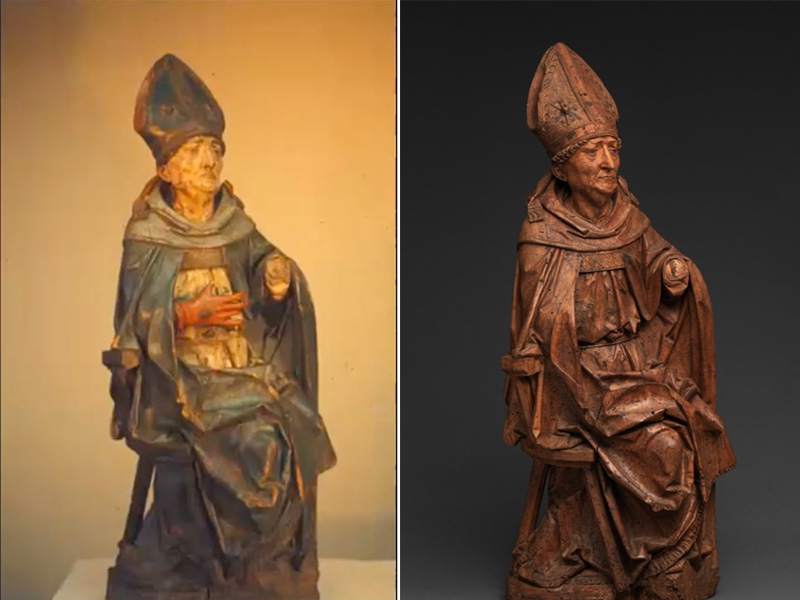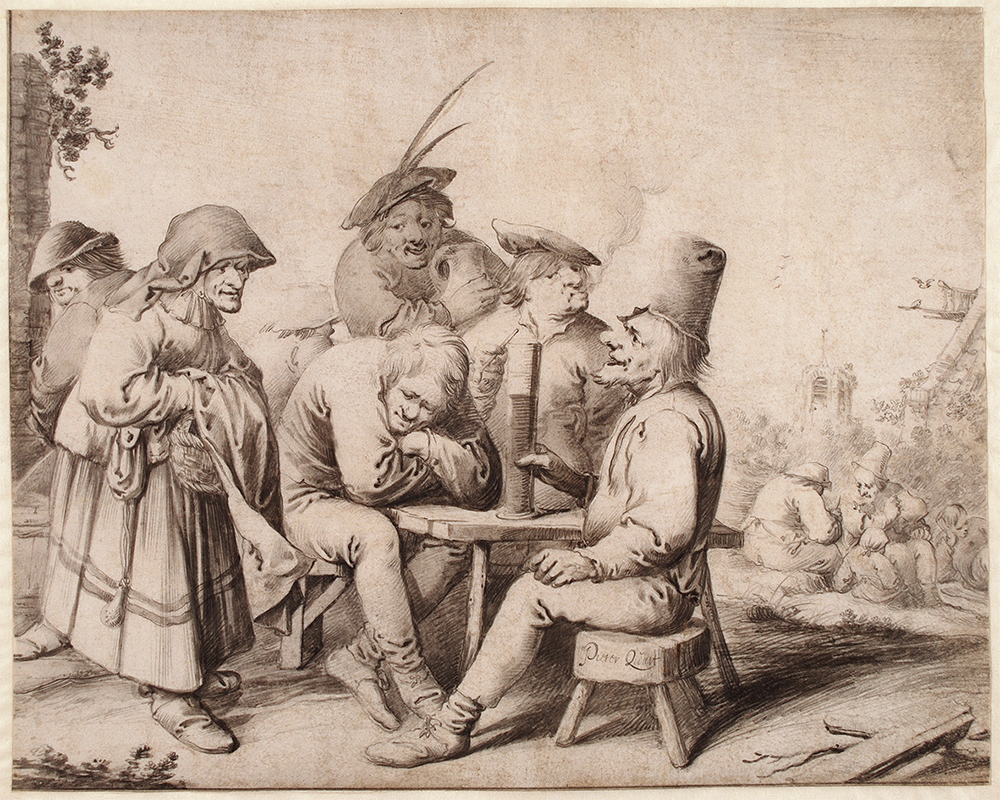
In an earlier blog post, I recounted my surprise to learn that both of the fine examples of German Renaissance limewood sculpture in North Carolina that I set out to study as the 2023 Ackland Huntley Fellow were once fully painted. This led to further consideration as to why these sculptures were — prior to their acquisition by the Ackland Art Museum and the North Carolina Museum of Art — stripped of the polychrome and gilding that once adorned them. In both cases, the stripping was quite aggressive and caused further damage to the surfaces of the sculptures. At the NCMA, Tilman Riemenschneider’s (German, 1460-1531) Female Saint was heavily abraded by the use of caustic lye in the stripping process. And while it is hard to know for sure at this juncture what was used to remove the paint from the Ackland’s Altötting Master’s (German, active first quarter of 16th century) triptych, the enormous amount of later infill along the wood grain might suggest that a similarly caustic substance ultimately “melted” parts of the grain when a past “conservator” tried to remove pigment.

Left: The hand of Tilman Riemenschneider’s Female Saint at the NCMA. Note the chisel marks still visible at the tips of the fingers. Conservators believe that if this sculpture had been intended to be left unpainted, like the Riemenschneider sculpture on the right, these chisel marks would have been more thoroughly obscured by an artist with such a reputation for fine work as Riemenschneider. Tilman Riemenschneider, Female Saint, c.1490-1495, Purchased with funds from the State of North Carolina and the North Carolina State Art Society (Robert F. Phifer Bequest) 68.33.1.
Right: The hand of Tilman Riemenschneider’s St. Erasmus in his sculptural group Sts. Christopher, Eustace, and Erasmus (Three Helper Saints). This sculpture, which was never intended to be painted, shows how fine a finish one can expect on a Riemenschneider sculpture. Tilman Riemenschneider, Sts. Christopher, Eustace, and Erasmus (Three Helper Saints), c.1500-1505, Metropolitan Museum of Art, The Cloisters Collection, 1961, 61.86.

Above, we see an example of a painted sculpture by Riemenschneider. The artist has become famous for his virtuosity in unpainted wood sculpture that is full of life and expression, but he also created a large oeuvre of painted wood sculpture. Workshop of Tilman Riemenschneider, Standing Bishop, c.1505, The Cloisters Collection, 1975, 1975.25.
I have come to find out that in the nineteenth and twentieth centuries, many sculptures were stripped of their pigment. Why? Well, it is possible that some of those instances were quite innocent, and the conservators thought they were removing later, anachronistic polychrome that was not part of the original look of the sculpture. Such was the case in the 1970s, when conservators at The Cloisters in New York carefully and successfully removed paint from Riemenschneider’s Seated Bishop, which they found was added to the sculpture in the eighteenth century. In other circumstances, it would seem that there was an aesthetic preference for unpainted sculpture, both as regards medieval wood sculpture and even ancient marble sculpture, and surviving original pigment was removed to improve the appearance of the sculpture to more understated nineteenth- and twentieth-century tastes.

Left: The appearance of Riemenschneider’s Seated Bishop prior to the removal of anachronistic eighteenth-century overpaint and a later right hand by Rudolf Meyer around 1970. Technical study of the surface of the wood revealed that the sculpture was intended to be unpainted and covered with a transparent glaze. This photo appeared in Michele Marincola and Lucretia Kargère, “The Conservation of Medieval Polychrome Wood Sculpture,” lecture, 18 March 2021, Institute of Fine Arts, New York, https://vimeo.com/535486700.
Right: The present appearance of Riemenschneider’s Seated Bishop. Tilman Riemenschneider, Seated Bishop, c.1495, The Cloisters Collection, 1970, 1970.137.1.
In the cases of the Altötting Master triptych and the Riemenschneider Female Saint, it seems likely that the pigment was original to the sculptures, especially the Riemenschneider. But Riemenschneider is famous for his unpainted wood sculpture, and indeed, the whole period, of which the Altötting Master is part, is much admired for this innovation: the artists’ ability to maintain great lifelikeness and vitality without reliance on paint. Still, we know that quite a lot of painted sculpture was nonetheless also produced.
Perhaps those who removed the paint on the Altötting and the Riemenschneider wanted these sculptures to better fit within that elevated, unpainted oeuvre. Maybe they thought the sculptures could command a better price that way. On the other hand, perhaps they thought that, given the popularity of unpainted wood sculpture in the period, the paint they found must have been a later addition, as in the case of the Riemenschneider Seated Bishop at The Cloisters, and thus chose to remove it. Perhaps they thought the paint made the sculpture look too “new,” and to appeal to an antiquarian market, they removed it. It is impossible to know for sure. But when the Altötting triptych was photographed in the 1940s, it would seem that pigment and gilding, touched up or not, survived relatively well. There are clearly color variations in the scenes themselves, and the borders glisten with what must be gold. Sometime over the next sixty years of its life, someone disapproved of the painted look and went to great effort to alter it.

The ERR-made photo of the Altötting Master triptych in 1941. See my earlier blog post for the interesting provenance of this triptych. Bundesarchiv B3232-881-fol.008.
Hannah Williams is a PhD candidate and Teaching Fellow in art history at UNC, where she is writing a dissertation on late medieval devotional micro-sculpture. As the 2023 Huntley Fellow, she researched two excellent examples of sixteenth-century limewood sculptures from Germany now in North Carolina collections: the house altar by the Master of the Altötting Doors (German, active c.1500-1525) at the Ackland Art Museum and a small sculpture of a female saint by Tilman Riemenschneider (German, 1460-1531) in the North Carolina Museum of Art.
Image credit, left: see photo immediately above.
Image credit, right: Master of the Altötting Doors, German, early 16th century, Model Altar, 1520-1530, linden wood, inscriptions in ink, 35 7/16 x 24 3/8 in. (90 x 61.9 cm). Gift of the Tyche Foundation in honor of the 50th Anniversary of the Ackland Art Museum, 2008.19.


